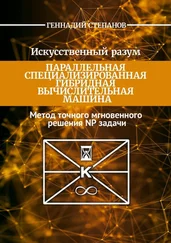– Other nuclear sites – including mines, low-grade ore processing
– Biological weapons research and development, manufacturing, testing, and storage sites
– CW research and development, manufacturing, testing, and storage sites.
Unclassified sources identify nine sites in the DPRK that fall into the first category: Yongbyon Nuclear Research Center, one nuclear test site, four additional undeclared nuclear enrichment sites, one suspected underground nuclear storage site, one undeclared underground enrichment and reprocessing site, and one site associated with nuclear weaponization. These nine nuclear sitesare shown in Figure 1.1.
The figure also depicts a notional buffer linethat might be established by Chinese forces—50 km in this example – in the event that China decides to establish a zone within North Korea to control the flow of refugees or otherwise manage further developments on the peninsula. An interesting feature of such a zone would be the number of priority WMD and missile sites remaining outside it. In this notional case, five nuclear and seven missile sites would remain on the U.S. side.
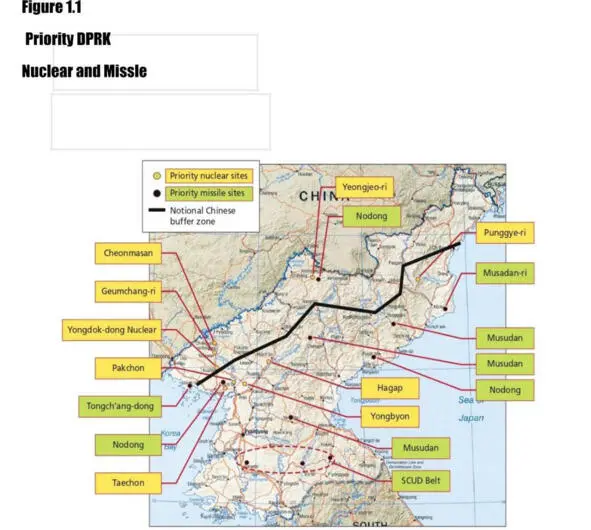
A key operational decision – and one that will be greatly affected by the quality of available intelligence – will be whether and in what priority to seize and reduce each site. The combined commander/JFC would then develop a campaign plan to exploit these and any other sites found during the course of operations.
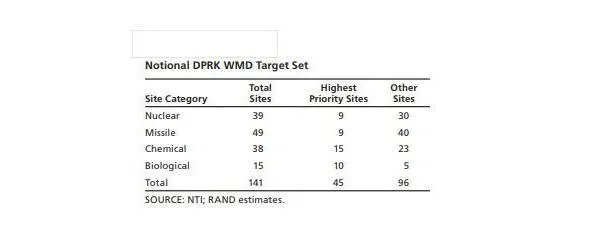
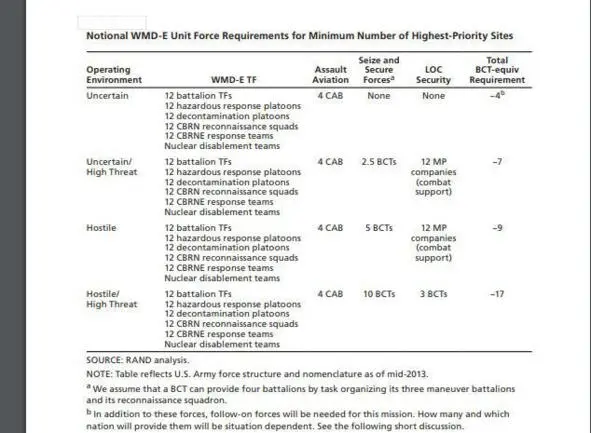
Table 1.3
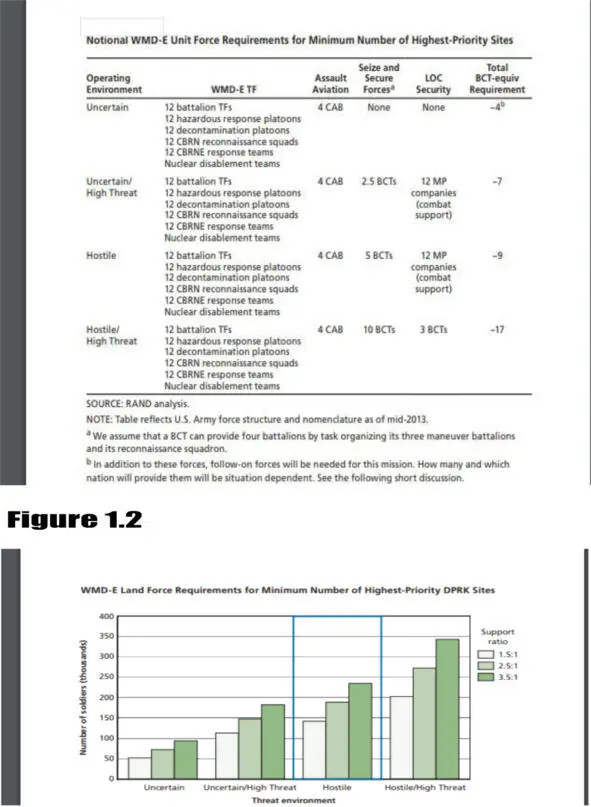
– Campaign Design
A WMD-E campaign would balance key objectives and missions; strategic, operational, and tactical risks; and the joint forces needed to interdict, attack, and/or eliminate nuclear forces and sites quickly enough to minimize the risks of proliferation or use. The WMD-E maneuver scheme could adopt one or a combination of the following approaches:
– a northward movement of U.S. ground forces and RoK allies across the DMZ along one or more axes of advance; (2) the introduction of forces from the sea on one or both coasts to reduce the distances that ground forces need to advance to reach priority nuclear WMD sites; and/or (3) air maneuver operations involving airborne or air assault forces directly assaulting the highest-priority sites, with other ground forces maneuvering to meet up with these forces, and joint SOF, air, and naval forces supporting.
– Intelligence Requirements.
The quality and reliabilityof U.S. intelligence will be critical in winnowing the number of sites to be initially assaulted, seized, and secured down to those that will best reduce the risk of WMD being leaked or employed.
For example, poor intelligencecan result in forces being sent to seize and secure sites bereft of WMD
Very good intelligencecould, in theory, reduce the number of sites requiring coverage, support the efficient allocation of limited resources, and reduce risk. (In practice, however, North Korean efforts to hide weapons and disguise sites may significantly diminish the effectiveness of U.S. and allied intelligence.)
Two intelligenceissues complicate planning for the WMD-E mission.
– First, intelligence gapswill likely mean that critical facilities rumored or reported to exist cannot be located.
– Second, as previously noted, many weapons – particularly CWs – are likely to have been dispersed to numerous tactical operational sitesthat cannot be identified in advance and are not included in estimates of a country’s WMD infrastructure.
3. Parametric Analyses of WMD-E Force Requirements
We estimated WMD-E forces under different scenario assumptions that varied the following parameters:
1 • the number and sizes of WMD sitesfor WMD-E operations
2• force requirementsdictated by the operational environment
3• the ratioof supporting forcesto mission forces.
– Sensitivity of Force Requirements to Operational Environments and Support Ratios The ground forcerequirements are presented as a function of the operating environment (Uncertain or Hostile, and level of threat) and the assumed support ratio (low, midlevel, or high), broken out by the different elements of the WMD-E mission force.
Ground force requirements for WMD-E operations in our illustrative DPRK case are presented in Figure 1.2.
Estimated forcesneeded for WMD-E operations could be…
5. Observations on the DPRK Case Study
As described in this case study, WMD-E operationsin the wake ofa collapse ofthe DPRK.
– What are the assumptionsdriving results?
– What does Your results suggest?
Welcome To The DPRK (Video)
https://drive.google.com/file/d/1YRUncnqAJ7YDe_N8UeRdpGOwFQZq KDwy/view? usp=sh aring
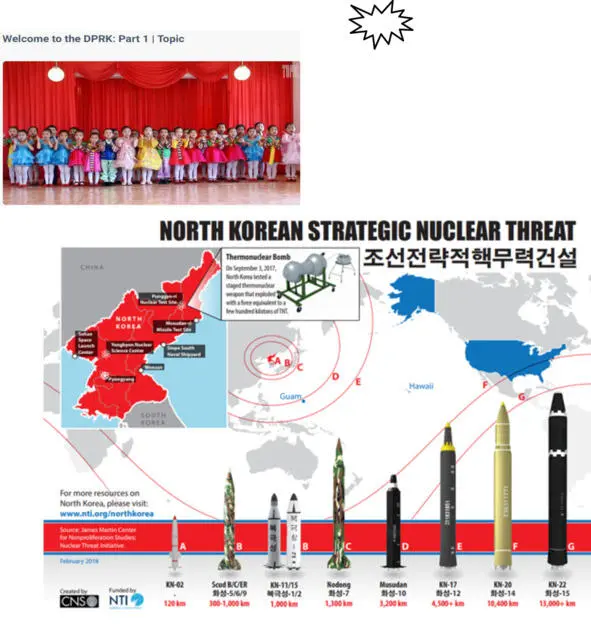

A WMD-E campaign would balance key objectives and missions; strategic, operational, and tactical risks; and the joint forces needed to interdict, attack, and/or eliminate nuclear forces and sites quickly enough to minimize the risks of proliferation or use.
The WMD-E maneuver scheme could adopt one or a combination of the following approaches:
– a northward movement of U.S. ground forces and RoK allies across the DMZ along one or more axes of advance; (2) the introduction of forces from the sea on one or both coasts to reduce the distances that ground forces need to advance to reach priority nuclear WMD sites; and/or (3) air maneuver operations involving airborne or air assault forces directly assaulting the highest-priority sites, with other ground forces maneuvering to meet up with these forces, and joint SOF, air, and naval forces supporting.
Answer
Each of the three approaches listed above involves associated benefits and risks.
For example, a northward advance would establish secure areas for elimination operations but could also be quite slow, and such an advance could well face the greatest concentration of opposing DPRK forces – hence, the highest casualties, especially if those DPRK forces had the ability and will to fight.
Читать дальше














